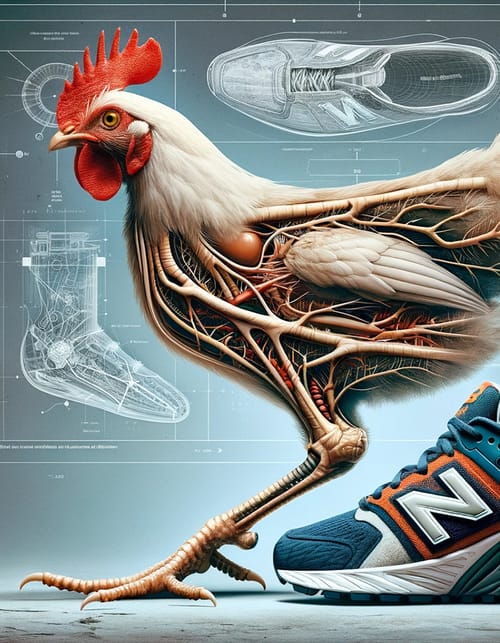Dear Friends,
Rejoining you after a refreshing break, I'm eager to share an inspiring story of how simple observations can spark extraordinary innovations in the most ordinary things, starting with a question that challenges a common perception.
All shoes are essentially the same, right?
You may be tempted to think so, but if you take a closer look at the design of New Balance shoes, you might be surprised.
When William J Riley founded his shoe company in 1906, he was far from satisfied with the design of existing trainers. Most shoes of the day had an insole with only two points of support – a design that often fell short when providing adequate arch support and cushioning.
Rather than settling for the status quo, Riley opted to design a shoe that addressed the shortcomings of existing designs.
He turned to nature for inspiration and was struck by the structure of a chicken’s feet – three clawed toes perfectly designed for balance on rough terrain.
Riley found the answer was the three support points system, a design concept he built into the shoes that came hours exploring how chicken feet worked. As Riley watched chickens run around the yard, he realized that the design of their feet provided perfect balance and stability. He then went on to apply this same principle to his shoes. The three support points insole was Riley’s major innovation, allowing for better arch support, improved cushioning, and greater shock absorption from impact.
The Birth of New Balance
Riley named his company ‘New Balance Arch Support Company’ and included chicken feet on his desk to demonstrate the concept of three support points to prospective customers. The company's name paid homage to the brand's unique blend of old-fashioned craftsmanship and innovative design - and how it helped the wearer achieve a new balance on their feet.
In 1960, Riley’s daughter Mary Ellen and her husband Paul Kidd bought the company, adding a ripple sole to create The Trackster. Today, New Balance has gone from strength to strength, manufacturing shoes beyond function to high fashion. And yet, within the sole of those shoes, the company's original design principle (inspired by chickens) remains. It shows how innovative ideas can often spring from the most unlikely sources. When we are dissatisfied with the status quo, sometimes we just need to push the boundaries to create something new and remarkable.

1- Learning from Nature for Innovation:
Riley’s breakthrough in shoe design underscores the importance of observational innovation - a concept where solutions are derived from keenly observing the natural world. This approach is akin to the principles of biomimicry, detailed in Janine Benyus' book "Biomimicry: Innovation Inspired by Nature." Biomimicry suggests that nature, evolved over billions of years, has already solved many problems we are grappling with. Riley’s use of the chicken’s foot structure as a model for better balance and support in footwear is a prime example of this type of innovation. It teaches us that sometimes the answers we seek are in the patterns and systems of the natural world around us.
2- Embracing Unconventional Inspiration in Design:
Riley’s story highlights the importance of seeking inspiration from unconventional sources. In the realm of design and creativity, stepping outside the norm can lead to groundbreaking ideas. This concept aligns with the ideas presented by Tim Brown in his TED Talk on design thinking, where he emphasizes the value of exploring a wide range of sources for inspiration. Brown argues that a multidisciplinary approach and the willingness to explore ideas outside one’s comfort zone are crucial for innovative design. Riley’s application of a structure from nature to solve a human ergonomic problem is a testament to this philosophy.
3- Turning Challenges into Innovation Opportunities:
The way Riley addressed the shortcomings in shoe design of his era shows how challenges can become opportunities for innovation. Clayton M. Christensen, in his book "The Innovator’s Dilemma," delves into how businesses can use their challenges to create innovative solutions that don’t just solve immediate problems but also open new market opportunities. By tackling the issue of insufficient arch support in shoes, Riley didn't just enhance comfort but also established a new standard in shoe design.
These insights, drawn from the foundation of New Balance, offer valuable lessons in innovation, design thinking, and converting obstacles into chances for success. They encourage us to think broadly, seek unique inspirations, and view challenges as catalysts for breakthroughs.
Dream Big!
Hussain Almossawi

Magical Painting in 4K
I'm excited to share a preview of my newest public art video installation, Magical Painting. This piece features millions of delicately floating particles, each shifting in hue to craft a serene and mesmerizing atmosphere. The dynamic color transitions offer an immersive experience, inviting onlookers to immerse themselves in a world of tranquility. I hope it brings you as much joy as it brought me in creating it!
